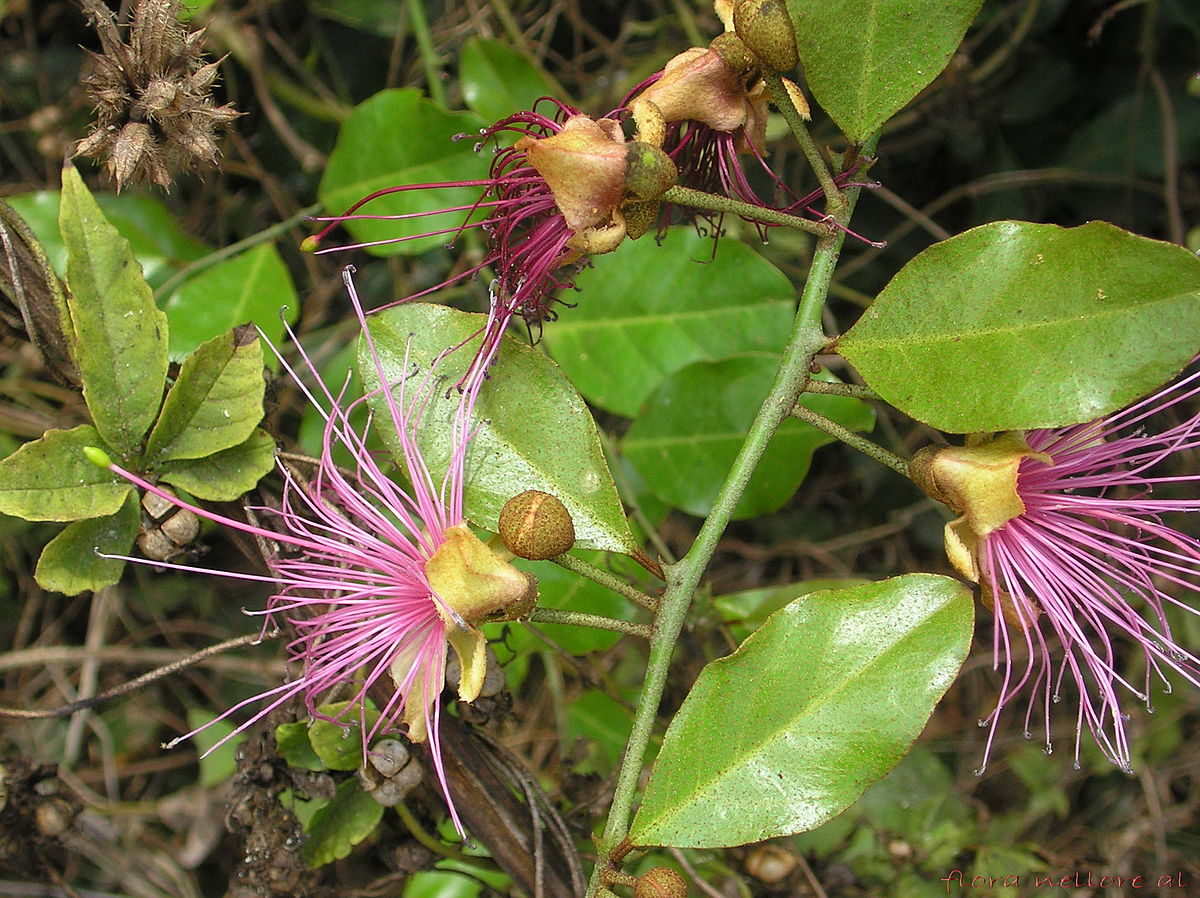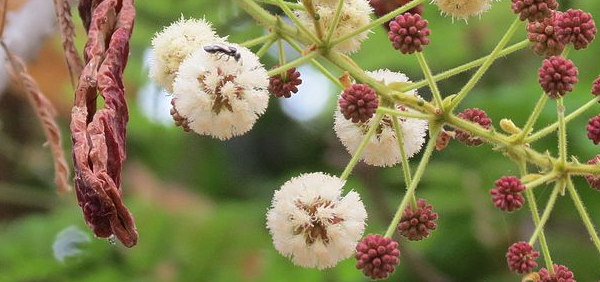vyaghranakhi :

Taxonomical Classification
Kingdom: Plantae - Plants
Subkingdom: Streptophyta
Superdivision: Spermatophyta - Seed plants
Division: Magnoliophyta - Flowering plants
Class: Magnoliopsida - Dicotyledons
Family: Capparidaceae
Genus: Capparis
Species: Capparis zeylanica
VERNACULAR NAMES
Sanskrit: व्याघ्रनखी Vyaghranakhi , करम्भ karambha, तपसप्रिय tapasapriyaEnglish: Ceylon caper, Indian caper
Hindi: Aradanda
Urdu: بھارتی کاپیر
Telugu: Palaki
Bengali: kalokera কন্টকলতা, কালকেড়া, আসারিলতা, আসারি, বাগানই, কালোওকড়া,
Marathi: गोविंदी Govindi
Konkani: गोविंदफल Govindphal
Gujarathi: Karrallura •
Tamil: Adondai
Malayalam: Elippayar, Karthotti, Gitoran
Kannada: Mullukattari
Punjabi: ਗਰਨਾ garna, ਕਰਵੀਲਾ karwila, ਕਰਵੀਲੂੰ karwilun
Sindhi: انڊين ڪئپر
Arabic: الكبر الهندي alkibar alhindiu
Spanish: alcaparra india
Assamese: -Gobindaphal
Japanese: インドケイパー Indokeipā
Chinese: Chui Guo Teng
French: -câpres indiennes
German: -indische Kapriolen
Burma: -aindiy caper
Nepal: बन केरा Ban kera
Persian: -کاپیتان هند
Sinhalese: -ඉන්දියානු කපර් indiyānu kapar
Greek: ινδικό καπετάνιο indikó kapetánio
Synonyms
Synonyms in Ayurveda: करम्भ karambha, तपसप्रिय tapasapriya, व्याघ्रनखी vyaghra nakhiRasa: Kashaya Katu Madhura Tikta
Guna: Laghu Ruksha
Veerya: Ushna
Vipaka: Katu
Karma: Kaphahara Vatahara Vishahara-Anti toxic,
Cultivation:
A plant of low elevations in the tropics, where it is found at elevations up to 700 metres in areas with a distinct seasonal climatePropogation:
Seed -Harvesting:
The plant is harvested from the wild for local use as a medicine and occasionally as a foodPhytochemistry:
PHARMACOLOGY:
IMPORTANT FORMULATIONS – Bala TailaParts used for medicinal purpose
Fruit, ,Dosage:
As neededAntidote:
-Traditionally it is also used as antidote to snake biteMorphology:
Histology:
Fruit – Epicarp shows thick cuticle covering the single layered epidermal cells followed by thick walled parenchyma, filled with yellow contents, mesocarp composed of thick walled parenchyma, having groups of pitted sclereids at places along with some vascular strands, endocarp contains collapsed cells, abundant oil globules present.Geographical distribution:
Sri Lanka, Thailand, China (Guangdong, Guangxi, Hainan), Java, Lesser Sunda Isl. (Lombok, Sumbawa, Semau, Timor), Sulawesi (incl. Selayar Isl.), Philippines (Luzon, Mindoro, Mindanao), Moluccas (Sulu Arch.), Taiwan (I), Andamans (Middle Andamans, South Andamans), Myanmar [Burma] (widespread), India (widespread), Nepal, Bangladesh, Pakistan (Sind), Vietnam, LaosECOLOGICAL ASPECT:
C. zeylanica occurs in hedges, brushwood, savannas, forest borders, at low and medium altitudes, under seasonal climatic conditions.General Use:
Therapeutic Uses:
Severe head ache, Cough, Cold, Nasal congestion, Throat infectionSystemic Use:
Stomachic, SedativeAdministration:
Unripe fruit is prepared as pickle and taken along with foodPharmacological:
Root bark is sedative, cooling, cholagogue, stomachic and antihidrotic; along with spirit given in cholera. Leaves are used as a counter irritant and as a cataplasm in boils, swellings, piles and rheumatism. Flowers are used as laxative.Clinical trials:
Research:
Precautions:
Toxicity studies:
Use in other system of medicine:
In folk medicine, leaves used as cataplasm for boils, swelling and hemorrhoids. Decoction of root-bark used for vomiting and for improving the appetite. Leaves also used to improve the appetite.CONCLUSION:
Capparis zeylanica is a climbing shrub common in the forests of the Indian subcontinent, Indo-China, China and Malesia; no subspecies are listed in the Catalogue of Life. Several species of Lepidopteran larvae feed on its leaves.KEY WORDS: vyaghranakhi , Capparis zeylanica Linn.
- » Classification and names of vyaghranakhi
- » Synonyms and definitions of vyaghranakhi
- » Drug Properties of vyaghranakhi
- » Chemical Constituents of vyaghranakhi
- » Standardization of vyaghranakhi
- » Parts used and Dosage of vyaghranakhi
- » Morphology and Histology of vyaghranakhi
- » Distribution and Conservation of vyaghranakhi
- » Cultivation of vyaghranakhi
- » vyaghranakhi in the market
- » Medicinal Uses of vyaghranakhi
- » Researches and clinical trails of vyaghranakhi
- » vyaghranakhi in other sytems of medicine
- » Ayurvedic formulations with vyaghranakhi
- » Images of vyaghranakhi

Kotakkal Ayurveda - Mother land of modern ayurveda











